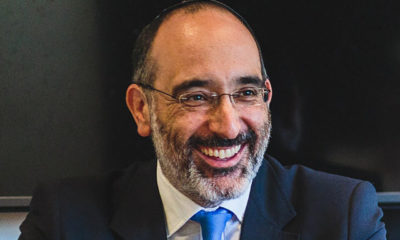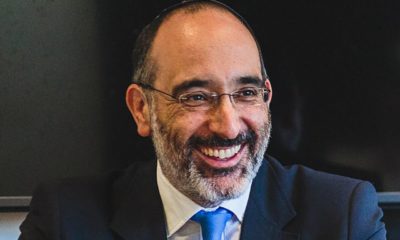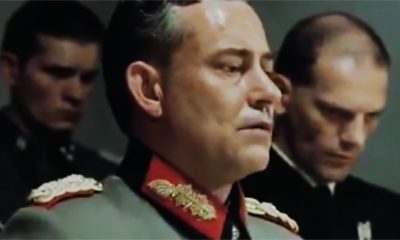
News
Parshat Beshalach – from the Chief’s desk
RABBI DR WARREN GOLDSTEIN
At the beginning of this week’s parsha, Beshalach, we find one of the most bitter, cynical complaints in history. The parsha begins with the Jewish people leaving Egypt. They get to the edge of the Red Sea and by this stage Pharaoh regrets having begged them to leave after the tenth plague, and he and his army are in hot pursuit to bring them back to Egypt. On the one side they see Pharaoh approaching them and on the other side they see the Red Sea. They are caught, literally, between the devil and the deep blue sea. Their reaction is cynical: hamibli ain kevarim beMitzraim lekachtanu lamut bamidbar, “were there were no graves in Egypt you have brought us to die in the desert?”
VISIT THE CHIEF RABBI’S WEBSITE
SUBSCRIBE TO HIS FREE E-MAILERS
Complaining is a natural human reaction to problems. They are stuck and frightened, Pharaoh is on the one side, the sea is on the other side and they don’t know how it’s going to end. They see no way out. Yet after everything they have seen – the ten plagues and all the miracles – it’s surprising that they would say something so cynical to Moses. Indeed, this was a terrible, bitter and cynical complaint on their part.
The Torah is a book of truth and implementable ideals
The fact that the Torah records this complaint shows that it’s a book of truth; it’s not a legend or fairy tale, but a recounting of the historical events which took place. If we were writing a happily-ever-after fairy tale, we would describe the ten plagues, how the Jews came out victoriously, happy and confident; how they came to the Red Sea, how they had faith in G-d and how the sea split. But the Torah is not a fairy tale, and so it records even this bitter cynicism because that is what actually happened. Throughout the Torah we find records of our great ancestors’ sins in full detail, because the Torah is a book of truth, not fables.
The Torah is also a book about living with ideals in the real world, with all its difficulties. On the one hand, the Torah is about G-d’s vision for us – the ideals, mitzvos, principles and values with which we are meant to live; on the other hand, we are real people, flesh and blood, and we make mistakes. The challenge is to translate G-d’s lofty ideals into the reality of our lives. This is why Torah law is called Halacha, which comes from the Hebrew word lalechet, “to walk.” It’s about taking those ideals and walking through life with them, making them a part of our life – literally “walking the talk.” G-d gave the Torah so that it will be implemented, and that is why all the “messy” details – the failures and sins of the people – are recorded. These are testimony to the fact that G-d gave us the Torah fully aware of our frailties, vulnerabilities and shortcomings. Despite our human limitations, He gave us the Torah because we are capable of living up to the ideals that He has given us.
Leading an ideal life in a less-than-ideal world
The parsha records that when they left Egypt, Moses took the bones of Joseph with him. They carried Joseph’s coffin throughout their forty-year journey in the desert and buried him once they got to the Land of Israel. When Yaakov died, he had left instructions to be buried in Israel and so when he died his body was moved immediately from Egypt to Israel. Yosef’s instructions were a bit different: he said pakod yifkod etchem, “G-d will remember you,” and when you are eventually redeemed, take me with you and bury me in the Land of Israel. He didn’t ask to be buried immediately in Israel, only when they left Egypt.
The Midrash says that as they travelled in the desert, two things walked in front of them: the Holy Ark which contained the Tablets on which the Ten Commandments were engraved, and Yosef’s coffin. It seems strange to have a coffin alongside the Holy Ark. But the Midrash explains that the reason for this was because Yosef had fulfilled the whole Torah, and so his coffin went alongside the Ark which contained the Tablets. The two went together – the Holy Ark, representing the ideal, and Yosef’s coffin, because Yosef exemplified how the ideal can be practiced and lived by in the real world.
Sometimes we wonder, can it really be done? We think, maybe it can be done in a perfect, ideal world but not in the imperfect world in which we live. But Yosef reminds us that it is indeed possible. Yosef lived in the real, imperfect and difficult world. He was sold at the age of 17; he had to find his way in the house of Potifar, overcome the temptation of committing adultery with Potifar’s wife and overcome the struggles of being in an Egyptian dungeon. And then, possibly his greatest test was that he went from the dungeon to becoming the viceroy, the second-in-command, of all of Egypt. He then had all the power, fame and fortune and yet he still remained loyal to the values of his father’s house. He lived under extremely challenging circumstances and proved that living with ideals in a less-than-ideal world is possible.
Rav Zalman Sorotzkin, in his commentary Oznayim LaTorah, discusses how the two aronot – the Ark and the coffin – went next to each other, to show the people that Torah is doable. They mustn’t think it is something for the heavens and that it cannot be achieved here on earth. Yosef is the proof of that and that is why his coffin goes in front of the people, next to the Ark: to inspire the people and show them that it is possible to live the ideals of Torah, whatever the circumstances.
Living with faith through all circumstances
But there could be another reason, another message, behind why Yosef’s coffin had to accompany them. The people in the desert were not just struggling with keeping the mitzvos. They were struggling with faith in G-d. Already when they left Egypt their faith was tested. They saw the Egyptians on the one side, the sea on the other and they thought, where is G-d? He has abandoned us. Their complaining and cynicism reflected a crisis of faith. The message behind why Yosef’s coffin had to accompany the people is that Yosef exemplified trust and faith in G-d even under difficult circumstances. It’s one thing to have faith and trust in G-d when things are going well; it’s another thing entirely when things are difficult. When you are seventeen years old and your own brothers turn against you and sell you into slavery and you land up in a foreign land where you can’t speak the language, and then just when you think things are going well you end up in a dungeon – we can only imagine how difficult it must have been for him. And yet he pulled through, with his faith intact.
Our faith is often tested in challenging times. Part of our faith is to believe that G-d is in control and that whatever happens, gam zu letovah – this too is for the good, even if we don’t always understand things and things don’t always turn out the way we want them to.
The fact that Yosef came through all his trials with his faith intact is seen very clearly when he reveals himself to his brothers and they are broken about what they had done to him, and he says to them, don’t worry, you intended for the bad, but G-d intended for the good; He sent me here to save this whole region from famine. We see that Yosef eventually figured out why everything had to happen. He understood why he had to go through all this pain and suffering – to save everyone from the famine. And again, after their father’s death, the brothers worried that Yosef would bear a grudge against them and Yosef says don’t worry, I can see G-d’s hand in this. Yosef knew all along that G-d is in control. And that is why he said to them pakod yifkod “G-d will remember you one day.” He was so confident that G-d would redeem them that he said don’t worry about burying me in Israel, I know I will get there eventually because G-d will redeem you from Egypt, and when he does, take my body with you. Yosef’s life exemplified faith and trust in G-d.
G-d’s master plan
The remarkable irony is this: Yosef thought he understood G-d’s plan, but he actually didn’t. The Gemara explains that Yosef was buried in Shechem, the very place where he waskidnapped and sold by his brothers; he was taken from Shechem and he was buried in Shechem, showing the completion of G-d’s plan, spanning a few hundred years. Yosef thought he understood G-d’s plan, but G-d’s plans don’t always work out in a matter of a few years. They can sometimes take decades and even centuries and longer. He thought G-d had sent him to Egypt because there was going to be a famine and he had to save the whole region from starvation. But in fact, G-d brought the famine so that Yaakov and his whole family would come down to Egypt. G-d wanted the whole family in Egypt so that we, as a people, would be born into the slavery of Egypt and then be liberated by G-d and witness the ten plagues and the splitting of the sea; He wanted us to be created as a nation through our freedom given by Him with miracles. For that to happen, we had to be in Egypt and so G-d brought a famine. Yosef thought he understood that he was there to save them from the famine, but actually the famine was there to get them all down to Egypt, then to Mount Sinai to receive the Torah, and eventually to the Promised Land. Thus G-d’s plan began and ended in Shechem; when they eventually re-enter the Land of Israel and Yosef is buried in Shechem, the circle is complete.
G-d’s plan works on a much larger scale than we can even begin to imagine. That’s why our trust and faith in G-d is often tested – we see only a fraction of the picture, a blurred glimpse. G-d sees the full picture. To us, it’s like looking at the back of a tapestry – it’s a knotty mess. But when viewed from the front, the beautiful picture can be seen. The message of Yosef’s coffin travelling with the people was to say, remember, here was a man who lived with trust and faith in G-d even through terrible suffering. His life represents Hashem’s incredible plan, that G-d is watching everything, even though His plan is sometimes brought to fruition not in a matter of weeks or months or even years, but decades and centuries and sometimes even longer.
The people travelling in the desert – ordinary people, flesh and blood – made all kinds of human mistakes and had many failures. And yet the Torah was given to them. G-d gave us the Torah knowing that we are mortals, because he wants us to live up to the greatest ideals. He wanted the people in that generation to live up to those ideals and the life story of Yosef is what inspired them to do so. Yosef showed that it can be done, that one can live a life of mitzvos and do the right thing and fulfil G-d’s will despite the circumstances. He showed what it means to have real trust and faith in Hashem, even when things don’t turn out the way we want. His life showed that there is a broader picture, a grander scale of history, that G-d is watching every detail and that He loves us and cares about us.
Let that be our inspiration to make the lofty ideals
of the Torah a real part of our day-to-day lives.










